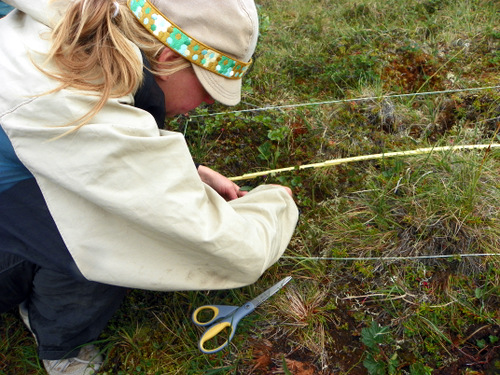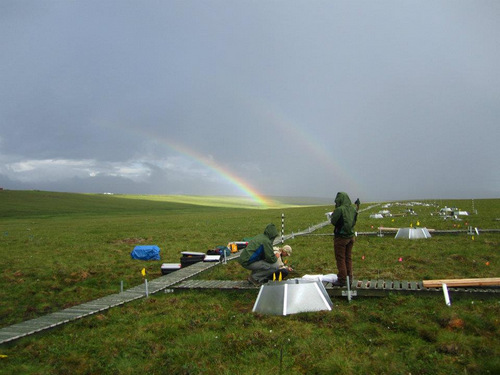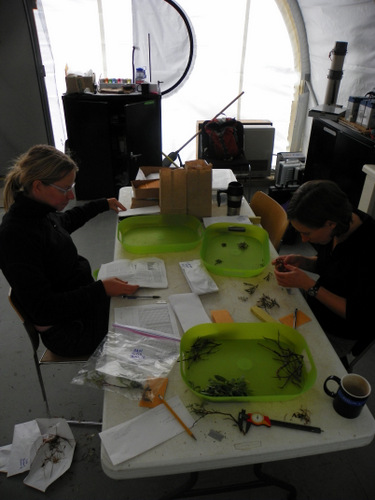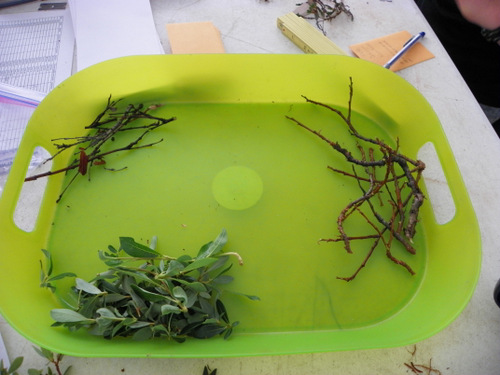Today I ventured back up to the Imnavait Creek Research Site to help Carolyn Livensperger and Heidi Steltzer of Fort Lewis College. Carolyn is a graduate student; Heidi is her advisor and a Principal Investigator on the project we were working on today. This is just another of many parts to the large Accelerated Snow Melt Project featured in my June 9 Journal. It's the same project that PolarTREC teacher Susan Steiner was a part of. You can read more about Susan's expedition by clicking this link. The scope of this project is too broad for me to describe in one journal, but essentially they are measuring multiple factors associated with accelerated snow melt. They basically cover large plots of tundra with black tarp to speed up the snow melt on some areas while leaving other areas alone. The video below is from the project's web site , and shows the team deploying shade cloth over the snow.
http://youtu.be/Avl0ZJLFzDk
Heidi and Carolyn are interested in plant responses to global environmental change, and in this case to accelerated warming. Today we were here to measure this year's plant growth. The tundra we were working in consists of roughly 23 species of plants. Heidi and Carolyn focus on the most common of those. We took a randomly selected area and laid out a 40 cm long tape. Eight numbers were randomly selected. Each number corresponded to a distance on the measuring tape. Odd numbers went to the left of the tape, even numbers to the right. Markers were placed at each of the randomly determined locations. The team then set out to collect the four sample plants closest to each maker for each of the species they were studying. This method of randomly determining sampling locations is intended to eliminate bias in selecting plants to sample.

Heidi and Carolyn began clipping the randomly selected plants at ground level. My job was to label and package the plants by species. This was a great chance for me to become more familiar with the plants of the landscape that I had spent over a month working on. The weather didn't look promising and started out with some intermittent rain, but looking for a moose that had been spotted there yesterday and seeing a double rainbow kept spirits high.

I was feeling optimistic when we left camp this morning and left my rain pants behind. So I embraced the rain once it was clear that my pants were about to get soaked as I sat on the boardwalk bagging samples. I try to subscribe to the philosophy that weather should be embraced or ignored. Thankfully my synthetic layers dried quickly and I was comfortable again by the time we got back to camp for Lunch.
We each grabbed a bag of plants when we got back to the lab. The exact measurements taken varied based on the species, but the basic idea was to measure new plant growth and compare it to old plant growth. We first measured the diameter of the old growth stems, we then counted the points of new growth on each stem and carefully used razor blades to separate new growth from old growth. We also separated all dead material from the stems before placing all of this material in separate envelopes to be dried and weighed. The relative amounts of growth for each plant will then be compared to determine if the accelerated snow melt had caused any different growth responses in these plants. This is a very simplified explanation, and many other factors were considered. Studies like this are important when considering topics like shrub expansion in the Arctic. As shrubs expand throughout the tundra, they crowd out other species and can cause an overall decrease in biodiversity. Understanding plant responses to environmental change is essential to our understanding of complex topics like shrub expansion.


Yesterday's Mystery Picture
Yesterday's mystery picture showed a view of spider eggs under a microscope.


Comments